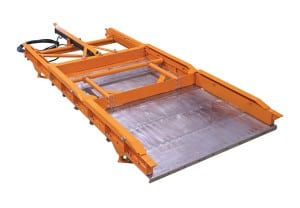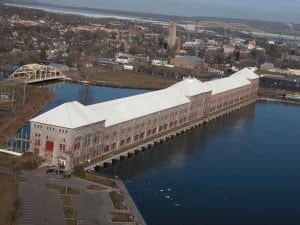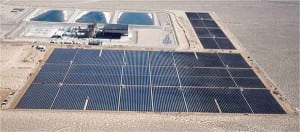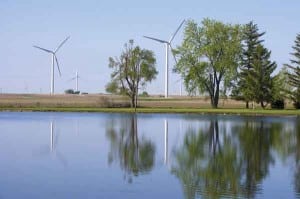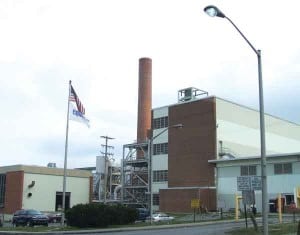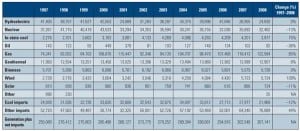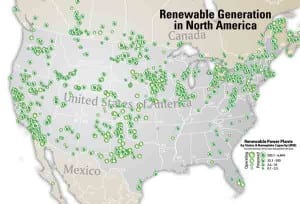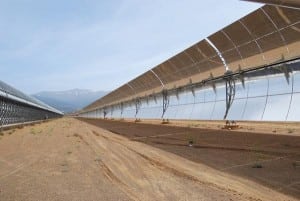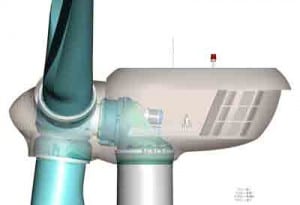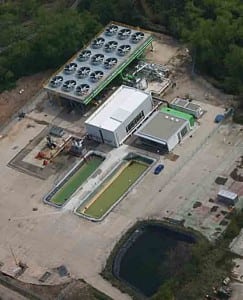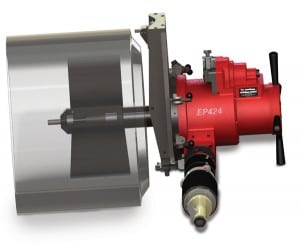In This Issue
-
News
Ocean Power Prototypes Coast Ahead in the UK
Marine energy prototypes in the UK are sailing ahead of entries from the rest of the world, propelled by government backing and public support.
-
Commentary
Power Politics: Enron Lives!
As director of public policy analysis in my last seven years at Enron, I participated in many legislative and regulatory debates involving electricity, although the public policy thrust of the company was the opposite of what I believed. While I favored free markets, the business model of Ken Lay (a PhD economist with years of Washington regulatory experience) centered on special government favor. Enron, for example, had seven profit centers geared to government pricing/rationing of carbon dioxide (CO2) emissions. And in the 1990s, the company was squarely behind a Btu tax. Today, Enron would be pushing cap and trade.
-
Business
Despite Economic Downturn, Renewable Energy Development Expected to Move Forward
While the overall economy is down, the effort to add renewable energy resources in the U.S. continues to push project development forward.
-
Gas
New-Generation Gas Turbines Steam Ahead
This September, as Siemens Energy wrapped up testing of its H-class SGT5-8000H gas turbine at E.ON’s Irsching 4 gas power plant in Bavaria, Germany, the company raved about what it is calling "the world’s most powerful gas turbine."
-
Coal
What Is BACT for CO2?
Assume, for the moment, that the U.S. Congress is unable to agree on legislation aimed at reducing carbon emissions from industry, vehicles, and power plants (the carrot approach). Further, assume that the Environmental Protection Agency (EPA) eventually promulgates rules that require power plants to reduce carbon emissions (the stick approach). Have you given any thought to the range of possible best available control technologies (BACT) that the EPA might require under the Clean Air Act (CAA)?
-
-
Nuclear
NRC Concerns About AP1000 Structural Strength Could Delay Projects
Concerns raised by the U.S. Nuclear Regulatory Commission (NRC) about the structural strength of Westinghouse Electric Co.’s AP1000 reactor could cause delays for several nuclear plants that planned to use the design in the U.S. — and it raises questions for new builds started or proposed in China and the UK.
-
O&M
Halar-Lined Chimney Remains Maintenance-Free
A fiberglass-reinforced plastic (FRP) Halar stack liner was installed at Vattenfall’s 300-MW Unit 2 at the Nordjylland Power Station in 1995. The 112-meter-high (367-ft) stack, protected from corrosion by the ECTFE liner, is still in excellent condition and has not required any repairs during more than 13 years of service. (ECTFE is short for ethylene chlorotrifluoroethlyene polymer, marketed under the brand name Halar ECTFE [Halar] by Solvay Solexis.)
-
O&M
Rebuilding Feedwater Heaters While a Plant Is Online
Rebuilding aged feedwater heaters can make better economic sense than buying new ones, because rebuilding reduces capital cost and plant outage expenses. At one Texas generating station, rebuilding saved one-third the cost of a new feedwater heater while improving the plant’s heat rate.
-
News
Automated Tube Bundle Water Jet System
The ATL-5000 — a new, fully automated water jet system from NLB Corp. — cleans tube bundles three times faster than manual methods and features an adjustable lance stroke that allows the system to be configured for bundles of various lengths, up to 30 feet. The diesel-powered system has five rigid lances, each with a […]
-
Legal & Regulatory
A Flood of Climate Change Tort Cases
On October 16, the Fifth Circuit Court of Appeals revived a lawsuit filed by residents along the Mississippi Gulf coast against several corporations in the energy, fossil fuels, and chemicals industries alleging that the defendants were responsible for property damage caused by Hurricane Katrina — Comer v. Murphy Oil USA, et al., No. 07-60756 (5th Cir. Oct. 16, 2009).
-
News
Scavenger Conveyor System
Martin Engineering introduced the Carryback Capture System, a scavenger conveyor system that transfers belt-cleaning residue back into the material stream, avoiding cleanup labor, injury potential, and dust hazards associated with buildup. The 13-inch-high system’s modular design uses an electrically driven hydraulic cylinder to push a steel cleaning blade — or, in a longer scavenger, a […]
-
Hydro
Top Plants: Edison Sault Hydroelectric Plant Sault Ste. Marie, Michigan
Located on the border with Canada and operational since 1902, the Edison Sault Hydroelectric Plant is one of the oldest continuously operating power plants in North America. This pioneer plant continues to generate between 25 to 30 MW when operating at full capacity. Modern wind and solar projects have captured the public’s interest, but this century-old hydroelectric project shows that time is the ultimate arbiter of a technology’s value to society.
-
News
Portable Combustion Analyzer
The updated E2200 Portable Combustion Analyzer from E Instruments is an all-in-one unit for boiler, burner, engine, turbine, furnace, and other combustion applications. Precalibrated and field-replaceable sensors allow for easy diagnostics and replacements to reduce downtime and costly repair charges. The analyzer includes sensors for oxygen (0% – 25%), carbon monoxide (0 – 8,000 ppm), […]
-
Solar
Top Plants: El Dorado Energy’s Solar Facility, Boulder City, Nevada
Sempra Generation has conjured up a market plan for producing merchant photovoltaic (PV) power that is inspired. Working with First Solar, Sempra has developed a finely tuned and standardized 1-MW PV power block that can be replicated as needed. Sempra built the modular PV plant on land adjacent to an existing gas-fired plant to shorten the development period, piggyback the power directly to the grid, and enable existing staff to manage the combined plants’ operation.
-
News
Belgium, Germany Edge Toward Nuclear Future
A host of European countries have recently made concessions on long-standing nuclear policies. In February this year, for example, Sweden proposed to lift a nearly 30-year-old ban on nuclear power and annulled its nuclear phase-out. And in May 2008, Italy announced it would resume building nuclear plants—two decades after public referendum banned nuclear power and the nation deactivated all of its reactors.
-
Wind
Top Plants: Fowler Ridge Wind Farm, Benton County, Indiana
The tractors and combines on Indiana’s farms are getting some competition from a new harvesting technology — powerful turbines that harvest wind. This March the Fowler Ridge Wind Farm opened its first phase, which consists of 222 wind turbines with a total capacity of 400 MW. Phase II is currently under construction and will use 133 wind turbines with a total capacity of 200 MW. A future, third phase will add another 150 MW and give the completed facility a total capacity of 750 MW, which will make it one of the largest wind farms in the world.
-
Waste to Energy
Top Plants: Harrisburg Resource Recovery Facility, Harrisburg, Pennsylvania
After decades of struggling with serious air contamination issues and large financial losses, this Pennsylvania waste-to-energy facility, which was built in 1972, was in need of an extreme makeover. In the wake of an unsuccessful $84 million retrofit attempt in 2005, the faltering facility’s last hope lay with a Covanta project team that took over its operation in 2007. After almost two years of hard work, the facility is now producing up to 17 MW while achieving its environmental compliance goals and earning substantial revenues.
-
Wind
Top Plants: Hywind Floating Wind Turbine, North Sea, Norway
In June, the 2.3-MW Hywind facility, the world’s first large-scale floating wind turbine, was towed to a North Sea location with a water depth of about 220 meters (722 feet) and began operation. Over the next two years this turbine will be subjected to strong wind and waves in a harsh ocean environment in an effort to thoroughly test the innovative technology.
-
Waste to Energy
Top Plants: Rio Bravo Rocklin Power Station, Lincoln, California
By 2008, the 19-year-old wood-fired Rio Bravo Rocklin Power Station’s operating performance had been significantly degraded by boiler erosion and corrosion caused by (among many other problems) poor fuel. After much consideration, the plant owners elected to invest in a comprehensive upgrade to restore the plant to its as-built performance. Today, the plant operates very reliably. A newly implemented predictive maintenance program should continue to drive down operating costs and further reduce the number of forced outages.
-
Geothermal
The Future of Geothermal
(Web supplement to "Assessing the Earthquake Risk of Enhanced Geothermal Systems.") The future of geothermal energy will be driven by six primary technologies, but each will pose its own challenges.
-
-
News
Argentina to Begin Commercial Operation of New Nuke by 2010
Argentina has set out to complete Atucha II, a nuclear reactor it started building in 1981 and abandoned when it was 81% complete, owing to financial problems. If all goes according to plan, the country’s third reactor could go online by 2011—some 25 years behind schedule.
-
Solar
The Power of Light: U.S. Solar Energy Trends
For decades, the solar energy industry has struggled to become cost-competitive with other sources of power generation. Recent technology innovations and creative ways of installing solar generation are beginning to enable solar power to increase its share of the electricity market.
-
News
Largest Wind Turbine to Be Built in the UK
A £4.4 million grant by the UK’s Department of Energy and Climate Change (DECC) this September to Clipper Windpower’s Britannia project kicked up a whirlwind of interest in the supersized wind turbine—and others being developed around the world.
-
Geothermal
Assessing the Earthquake Risk of Enhanced Geothermal Systems
Enhanced geothermal systems (EGS) deliberately induce seismicity — earthquakes — in order to access hot, subsurface rocks for use in geothermal power generation. Recent quakes around the world have frightened those living near EGS sites and sparked controversy over the technique. We asked experts to provide EGS technical details and to evaluate the seismic risk the process poses.
-
News
Coal Seam Gas Poised to Explode in Australia
Anglo Coal, one of Australia’s coal mining companies this September opened a 45.6-MW power plant at its Moranbah North mine in northeast Queensland that captures methane-rich coal mine gas and uses it as a fuel to generate power instead of venting it into the air.
-
News
End-Prep Machine Tool
The new Wachs EP 424 with the new Speed Prep feed system is a precision I.D.-mount end-prep machine tool designed to bevel, compound-bevel, J-prep, face, and counterbore pipe, fittings, and valves. The system uses a new Wachs mechanism that feeds simultaneously in the axial and radial planes. Wachs claims that the system is able to […]






